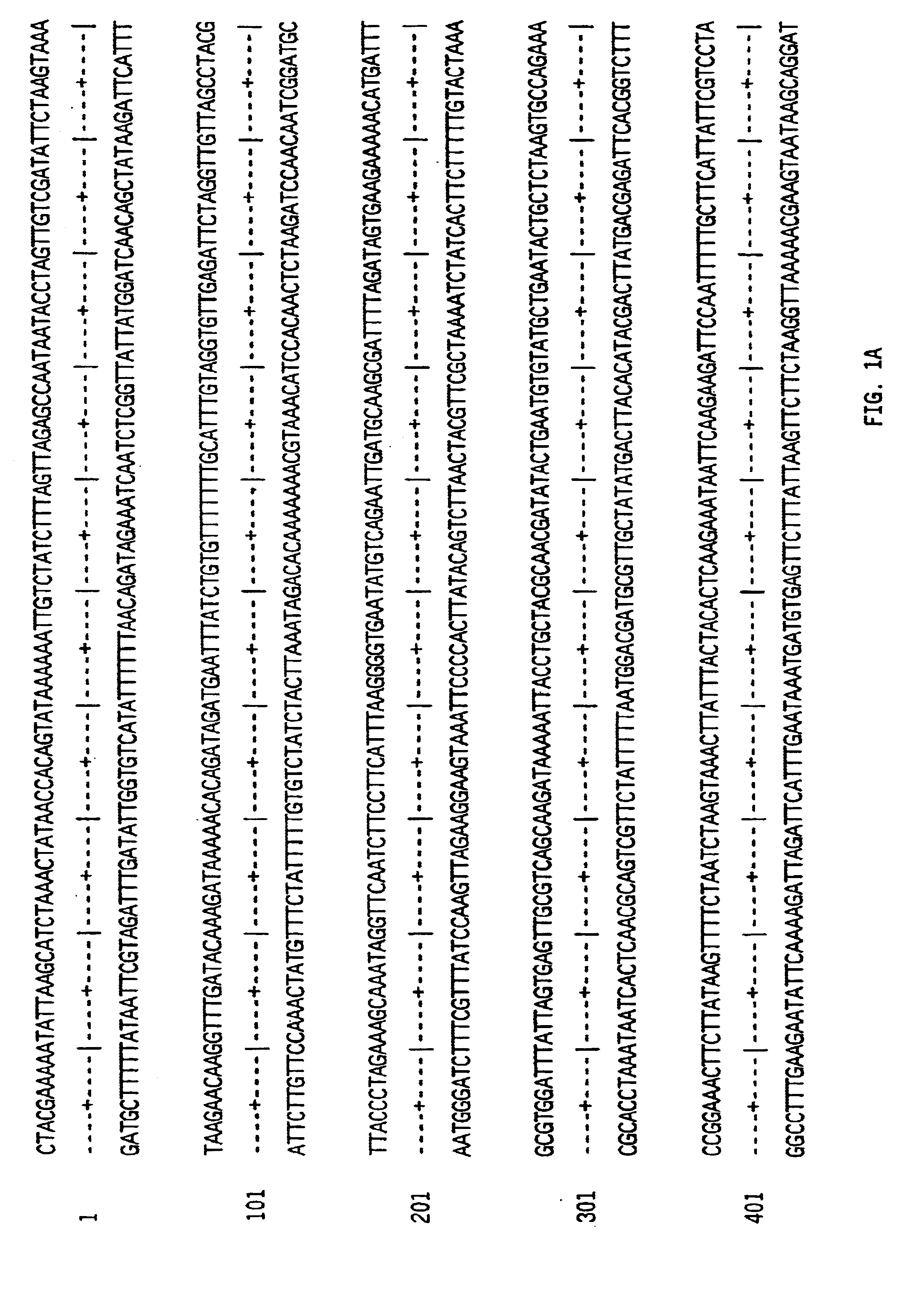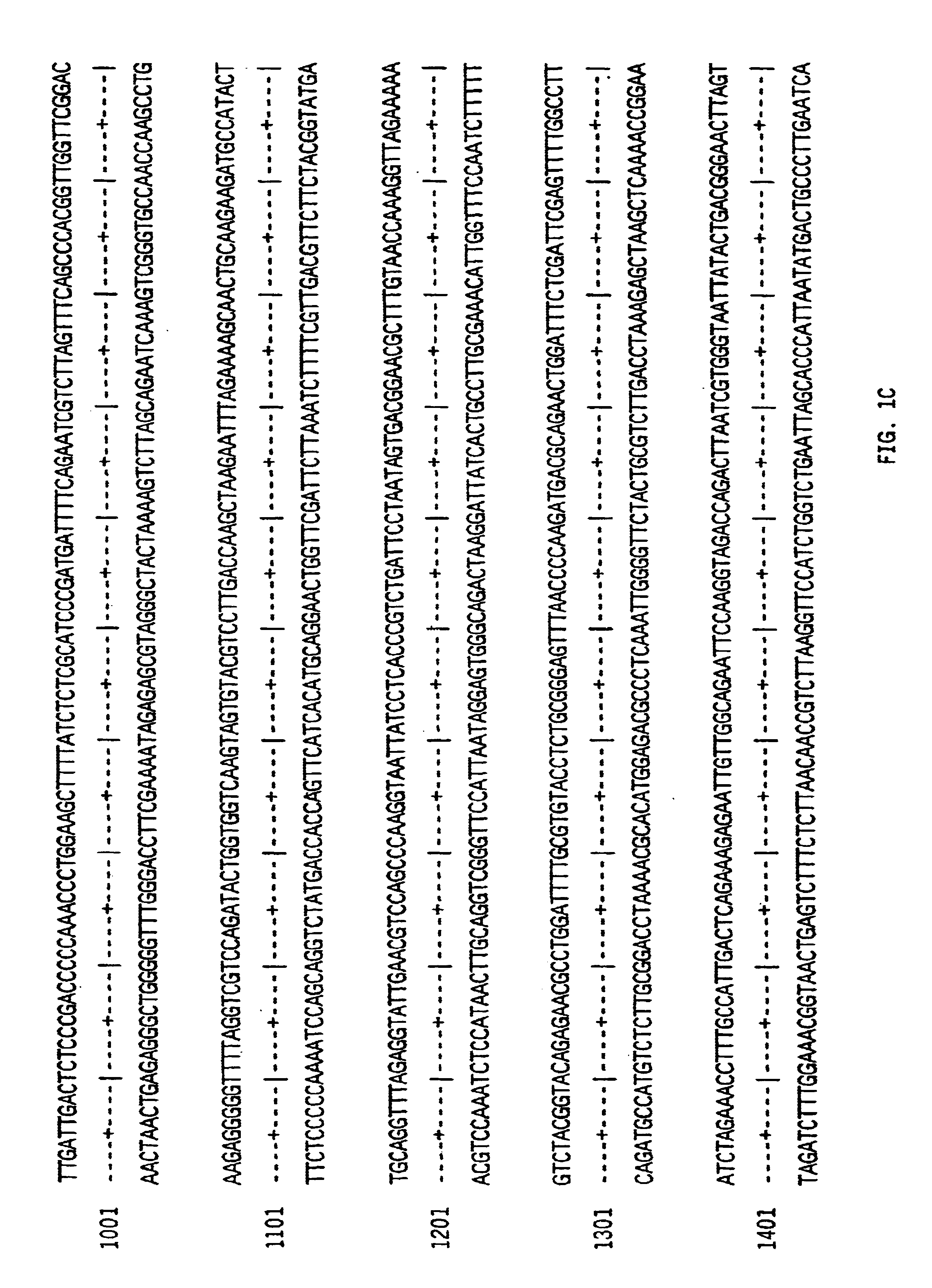Bacterial sucrose synthase compositions and methods of use
a technology of sucrose synthase and composition, applied in the field of molecular biology, can solve the problems of lacking in the prior art and achieve the effect of being readily commercially availabl
- Summary
- Abstract
- Description
- Claims
- Application Information
AI Technical Summary
Benefits of technology
Problems solved by technology
Method used
Image
Examples
example 1
5.1 Example 1
Construction of an Anabaena cDNA Library
5.1.1 Materials and Methods
5.1.1.1 Materials
All of the restriction endonucleases and the large fragment of DNA polymerase I (Klenow) used in this study were purchased from either New England BioLabs, Inc. (Beverly, Mass.), or Boehringer Mannheim Biochemicals (Indianapolis, Ind.). Deoxynucleoside triphosphates (dATP, dCTP, dTTP, and 7-deaza-dGTP), dideoxynucleoside triphosphates (ddATP, ddCTP, ddGTP, and ddTTP) were purchased from Pharmacia (Piscataway, N.J.). [.alpha.-.sup.35 S]-dATP, [.alpha.-.sup.32 P]-dCTP were purchased from DuPont, NEN Research Products (Boston, Mass.). Antibiotics were purchased from Sigma Chemical Co. (St. Louis, Mo.). All other chemicals were reagent grade and available commercially.
5.1.1.2 Culture Conditions
Anabaena sp. strain PCC 7120 was grown in modified Kratz and Myers medium C (K&M) or BG-11 medium (Kratz and Myers 1955; Rippka et al., 1979). In place of Na.sub.2 HPO.sub.4, 1.125 mM of both Na.sub.2 ...
example 2
5.2 Example 2
Identification of a Genomic Clone Containing sucA
5.2.1 Identification of a Bacterial Genomic Fragment With Similarity to Eukaryotic Sucrose Synthases
VegCDNA4, a bacterial cDNA of approximately 200 nucleotides, was identified as a random clone that was vegetative-cell specific. This sequence showed similarity to eukaryotic sucrose synthases. Based on this finding, the inventors were motivated to examine the DNA sequence and to identify a complete DNA sequence in this region. The 200-bp cDNA was sequenced and homology searches were performed using BLAST (GenBank) algorithm computer program analyses. The results of the computer analyses indicated that the nucleic acid sequence of this cDNA encoded a portion of a protein with similarity to eukaryotic sucrose synthases and sucrose phosphate synthase.
VegCDNA4 was used as a probe against a 2000 member cosmid bank, however positively-hybridizating clones were not identified under the particular hybridization conditions initiall...
example 3
5.3 Example 3
Cloning and DNA Sequence of Anabaena sucA
The following example describes the cloning and DNA sequence analysis of the Anabaena sucA gene, which was shown to have only 44% identity to the known plant sucrose synthase genes.
5.3.1 Materials and Methods
5.3.1.1 Isolation of a Full-length Genomic sucA Gene
The mutant chromosomal DNA was then restricted with ClaI and a small sample was removed, diluted and re-ligated intra-molecularly. The ligation mix was transformed into E. coli, and Kan- and Amp-resistant colonies were isolated. pCCB111aa was excised from this clone, pCCB1015a1, by restriction digestion with BamHI to form pCCB1015am. pACYC184 was inserted into the single ClaI site of pCCB1015am and following ligation, clones were selected on 10 .mu.g / ml chloramphenicol (Cml) and 100 .mu.g / ml Amp to form pCCB1015an. pCCB1015an was transformed into a recA.sup.+ strain of E. coli MC1061, and growth was allowed to continue overnight. Plasmids were isolated from these cultures an...
PUM
| Property | Measurement | Unit |
|---|---|---|
| temperatures | aaaaa | aaaaa |
| temperatures | aaaaa | aaaaa |
| temperatures | aaaaa | aaaaa |
Abstract
Description
Claims
Application Information
 Login to View More
Login to View More - R&D
- Intellectual Property
- Life Sciences
- Materials
- Tech Scout
- Unparalleled Data Quality
- Higher Quality Content
- 60% Fewer Hallucinations
Browse by: Latest US Patents, China's latest patents, Technical Efficacy Thesaurus, Application Domain, Technology Topic, Popular Technical Reports.
© 2025 PatSnap. All rights reserved.Legal|Privacy policy|Modern Slavery Act Transparency Statement|Sitemap|About US| Contact US: help@patsnap.com



